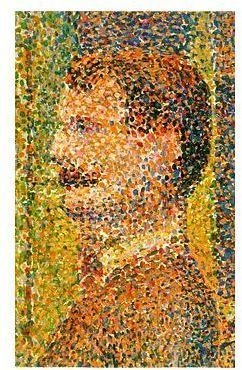Teaching Pointillism to High School Art Students
Science of Pointillism
A good pointillism art lesson plan for high school students should begin with a basic explanation of the history of the movement and
how it arose from relevant science of the mid-to-late 19th Century. This framework should help students see the relationship between science and art and underscore the value of how various disciplines build on one another.
In the case of pointillism, this technique arose from the French neo-impressionist art movement of the 1880s, in part as a response to scientific discoveries on the topic of color theory. While scientists and artists had long understood the notion of primary and secondary colors, American physicist Ogden Rood added a new perspective on color with his work Modern Chromatics, with Applications to Art and Industry published in 1879. Rood suggested that small patches of various colors, when viewed from a distance, would create the illusion of blended shades and hues. In addition to Rood’s work, French chemist Michel Eugene Chevreul also contributed to the neo-impressionist understanding of color, science and art. Chevreul discovered that in tapestries, yarn dyes of neighboring strands of yarn contribute to the color which is perceived by the viewer. From this he was able to extrapolate an enhanced version of the existing color wheel. This application of how the eye interprets color greatly influenced the key artists in pointillism.
Seurat’s Grand Painting
The most notable artist in the pointillism movement was French painter Georges Seurat. Seurat’s most famous work, A Sunday Afternoon on the Island La Grande Jatte, was also the first featured exhibit in pointillism. While it was initially rejected by art critics, it eventually became one of the signature pieces of the 19th century, and the most notable work in the neo-impressionist movement.
Seurat’s painting employed all of the theories of Rood and Chevreul. From a distance, the piece depicts a park with afternoon sunlight and a variety of guests enjoying the day individually and in small groups. Upon close examination the enormous canvas is made up of millions of tiny dots of paint. Soft edges, blended shades, hues and tones are built entirely from small overlapping and neighboring bits of colors. While there were a few other artists who produced works using pointillism – such as Paul Signac and Henri-Edmond Cross – Seurat’s “Grande Jatte” is a perfectly sufficient example for the sake of a pointillism art lesson plan.
Originals Versus Reproductions
To provide students with an opportunity to practice pointillism, the decision should be made beforehand whether the work will be an original piece or a reproduction. In the case of an original piece, students should be encouraged to select a subject matter that includes secondary colors. This will necessitate the use of overlapping and side-by-side primary colors. An example might be a batch of balloons including shades of purple, green, and orange. Allowing students to choose their own subject matter may prove to be too complicated for a pointillism project, but might be the proper approach for an advanced art class where students are given more time per project. In a beginner’s art class it might be best to suggest students reproduce a certain segment of Seurat’s work, such as a particular figure or group of figures.
In terms of supplies for a pointillism art lesson plan, oil paint is the best medium for this project as it tends not to drip or run. Fine brushes are required for accomplishing the size of the dots and a high quality color wheel is necessary for students to know which colors oppose one another and offer the highest contrast for visibility.
Wrapping It Up
This pointillism art lesson plan should help students understand the history of pointillism, the most significant artist and work within the movement and the difficulty of producing a sample piece using this technique.
